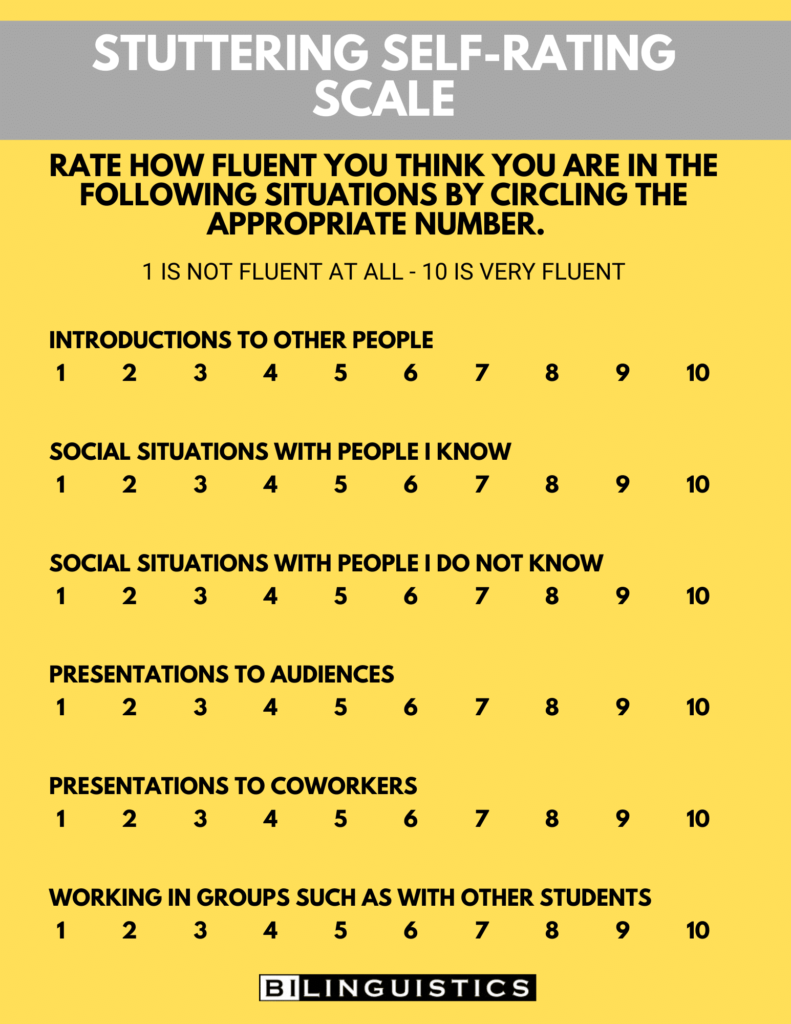Obtaining objective fluency self-rating scale information is the foundation for incredible fluency speech therapy for both with adults and children.
- It can establish a strong and close bond between therapist and client because of what is disclosed
- It gives you the exact ways a fluency client wants to improve
- It allows you to easily identify obtainable goals and levels of support or mastery
- When put up against your data on stuttering and stuttering-like instances, it tells you whether someone is over- or under-estimating how much they stutter.

It is a pot of gold.
And yet, why is accurate data so difficult to obtain?
It is difficult for all of us to talk about things that are uncomfortable or carry emotional weight. And without actual data or something to compare to, most of us are not great at describing our abilities or habits accurately.
This goes for over-estimating or under-estimating nearly everything. From how much we eat to how much we exercise. From how well we sing Karaoke to how well we dance. My favorite data perception study relates to whether people think their driving skills are average or above average.
“Despite the fact that more than 90% of crashes involve human error, three-quarters (73 percent) of US drivers consider themselves better-than-average.
AAA Study
Obviously 73% can’t be above average. But who is overestimating? Not me, of course. It has to be all those other drivers 😉.
Secondly, we are less likely to provide objective information to a stranger. When talking about a fluency self-rating scale, this is usually conducted in the first few sessions so we can establish the much needed “baseline.” Setting all degrees of fluency, age of client, and experience with therapy aside, can we actually get accurate fluency self-assessment information if rapport hasn’t been established?
Thirdly, how on earth do we think we are going to capture a person’s perception of a life-long experience with stuttering in a single session or a handful of questions? No, it’s obvious why self-perception scales, fluency self-rating scale, or stuttering severity rating scales are hard to use correctly. And yet, the information they have the potential to provide is crucial to success.
So how do speech language pathologists gather fluency self-rating scale information well?
- Like any good interviewer, we need to ask the same question coming from different angles.
- We ask the questions directly. And because this can feel confrontational, we also give some “homework” so things can be thought about alone and reflected upon.
- We are also going to step outside of the box and consider how the client thinks others perceive their fluency, and with a twist, how fluent they think others are.
In the end, we want to arrive at a place where we have a fluency self-assessment that provides us with goals for the client, what they are comfortable with, what strategies they already know, and where to start. Rather than belabor the point, let’s do this in two parts with all the materials you need to run your session and fluency homework activities to do between sessions.

X-Ray on a Speech Therapy Session to Gather Stuttering Self-Rating Data
Fluency speech therapy is way different than working with most speech disorders because the client probably has history with speech therapy and a relationship with his or her fluency. The client might actually be more knowledgeable about fluency than you are!
I think fluency improvement is most powerful and most successful when it is:
- A collaboration, not a teaching session
- Picking up where the client left off, not starting something new
- Focused on the client’s goal, like feeling comfortable giving a speech or ordering food, not driving towards a fluency metric
I will even go so far as to suggest that from this point forward, we change our language to talking about fluency collaboration sessions rather than fluency or stuttering therapy.
Therapy Session Introduction and Overview
This is what today’s session is going to look like.
I want to hear about you and your fluency. What have you done before? What has your experience been? Did you like speech therapy before? Be honest! This obviously isn’t something new to you. I want to know where to pick things up and how best to collaborate with you to get the outcomes you want.
We are going to review the areas of your life and where you want to improve in order to see what is most important to you right now.
We will talk about prior goals and see if there are any specific words or situations that you want to improve.
We will talk about ways people are disfluent and ways that you specifically are disfluent.
We will talk about how you feel when you are disfluent and ways to modify those feelings.
We will take some listening, reading, and speaking samples to identify what kind of disfluency is taking place.
We will talk about ways to improve disfluency.
We will choose your favorite ways to address disfluency and practice those.
Self-Assessment of Fluency
Begin with a standard survey-style fluency self-rating scale. This will get them thinking in the right direction and ease them into some of the activities that are coming next. Use your own or use this here:
Stuttering Self-Rating Scale
Rate how fluent you think you are in the following situations by putting a check mark in the appropriate box. 10 is very fluent. 1 is not fluent at all.

Redirected Questions to Rate Fluency
Stealing ideas from interviewing and journalism gurus, we can get improved information if we use different question formats to arrive at the same answers. Rather than the quick, numerical responses above, ask similar questions with written or verbal responses.
Answer the following questions:
- Are there other situations not listed above when you feel that you are not as fluent as you would like to be?
- Are there specific words that cause trouble?
- Are there times when you feel more or less comfortable stuttering?
- Do you avoid situations because of fears that you might stutter? Which situations?
- Do you feel that you are not taking advantage of any opportunities in life because your stuttering is holding you back?
- Do you think that others perceive of you differently because of your stuttering? Do you interact less or act differently when you are concerned about your stuttering?
- What strategies have you developed to be able to reduce your stuttering?
- (When coming from prior speech therapy) Do you remember some of the goals that you had when you working on stuttering before?
Gathering Fluency Self-Rating Scale Information During the Session
At this point we are about halfway there. To be honest, when I was less successful with fluency clients, this is where my information gathering ended.
We have to remember that this person may have had LOADS of speech therapy so we need to find out what they know and what strategies they use. We need to learn what has been effective in the past and what hasn’t.
We are the objective observer. We need some quick, solid data to establish where they are struggling. This is so important because of how radically different fluency can be based on what is going on in a person’s life. It doesn’t matter if you have a brand-new evaluation or great data from above. You need your own numbers.
We are going to gather three types of data here: Reading, Conversation, and Confrontational Conversation
Reading Fluency Self-Assessment
Okay, so here’s what we are going to do. We are going to have two short conversations and then we are going to read something to rate your fluency together. Is it okay if I record it? We will only use it here:
Read anything or you can use the trusty rainbow passage:
The Rainbow Passage
When the sunlight strikes raindrops in the air, they act as a prism and form a rainbow. The rainbow is a division of white light into many beautiful colors. These take the shape of a long round arch, with its path high above, and its two ends apparently beyond the horizon. There is , according to legend, a boiling pot of gold at one end. People look, but no one ever finds it. When a man looks for something beyond his reach, his friends say he is looking for the pot of gold at the end of the rainbow. Throughout the centuries people have explained the rainbow in various ways. Some have accepted it as a miracle without physical explanation. To the Hebrews it was a token that there would be no more universal floods. The Greeks used to imagine that it was a sign from the gods to foretell war or heavy rain. The Norsemen considered the rainbow as a bridge over which the gods passed from earth to their home in the sky. Others have tried to explain the phenomenon physically. Aristotle thought that the rainbow was caused by reflection of the sun’s rays by the rain. Since then physicists have found that it is not reflection, but refraction by the raindrops which causes the rainbows. Many complicated ideas about the rainbow have been formed. The difference in the rainbow depends considerably upon the size of the drops, and the width of the colored band increases as the size of the drops increases. The actual primary rainbow observed is said to be the effect of super-imposition of a number of bows. If the red of the second bow falls upon the green of the first, the result is to give a bow with an abnormally wide yellow band, since red and green light when mixed form yellow. This is a very common type of bow, one showing mainly red and yellow, with little or no green or blue.
From Fairbanks, G. (1960). Voice and articulation drillbook, 2nd edn. New York: Harper & Row. pp124-139.
Conversational Fluency Self-Assessment
In this conversational segment you want to ask simple questions and let them speak. Only interject to get more information. One to three minutes is plenty
- Before you were telling me you liked to do…
- That’s really interesting! Tell me more about… How do you…?
- You said your family is… Talk about each person.
Conversational Challenge Fluency Self-Assessment
This last part is designed to simulate real conversation. If you have recently walked down the halls at school or through the playground, you know that kids disrupt each other constantly and jump in and out of conversations. Your job is to do the same here.
Choose a current events topic or something that you already discussed in the interview. Get animated! When they start to talk. Interrupt them in an encouraging way. This may feel rude but keep smiling and have fun. Tell them what you are up to and keep it short!
- You: So you played in the orchestra? How long was that?
- Client: Well, I played four years in high school but went
- You: No way!
- Client: went on to play
- You: Four years!
- Client: went on to play in college.
- You: Do you still play now?
- Client: Sometimes, like when I
- You: For your family?
- Client: yeah, sometimes but usually in church when
- You: Like on holidays?
A REAL, Not-Your-Grampa’s Fluency Self-Assessment
Dear reader, if you made it this far you see that we have dramatically improved what it means to use a fluency self-rating scale. However, we have not fully gained authentic information.
By definition, in order to self-assess we need three things:
- Personal knowledge
- Accurate data
- Objectivity
Up until now. You held the knowledge. You gathered the data. And you asked them to be objective. In this last section we are going to teach a bit of our jobs and then ask them to assess their own fluency.

Before we begin, we have to ask permission to do this. Some people who stutter will not be comfortable listening to themselves. If that is the case, you just analyze their three fluency samples after the session and use it to formulate the goals for the next session.
We don’t want to cross a line and make them feel worse about stuttering.
You just heard their samples. If they are highly disfluent you may not want to take this last step yet. Instead, keep the samples as a baseline, do therapy for a while, take the same data using whatever modification or enhancing strategies you taught, and compare the before or after.
However, in the instance where a client is open to it, it can be empowering. Here’s why:
- Fluency is not all-encompassing. They will normally see that they are more or less fluent in one area versus another. For example, typically they may read well. This helps to show them that fluency isn’t this one BIG thing but manifests itself in different ways.
- Fear is often greater than reality. There is a probability that they think they stutter worse than they do. I have had a client say: “That wasn’t bad!” Helping them feel more comfortable with their speech can be as important, if not more important than fluent speech itself.
- It makes fluency tangible. Numbers and data make improvement possible. Rather than “becoming more fluent” they see that they “use part-phrase repetitions at the beginning of sentences.” Which is easier to correct?
Teaching Fluency
We are all disfluent in different ways and different amounts. When I have to give a presentation or meet someone new, I repeat myself and say a lot of “Ums.” Have you seen this before? (If yes, let’s review). Basically, there are a handful of ways that people stutter. Let’s take a look at these and I will give you some examples.
Stuttering-like Disfluencies and Examples
| Single Syllable Repetition | (e.g. “tea,tea,teacher”) |
| Whole Word Repetition | (e.g. “I was-was there.”) |
| Audible Sound Prolongation | (e.g. “Mmmmore please.”) |
| Inaudible Sound Prolongation | (e.g. “(M—) More please.”) |
| Blocks | No ability to begin a word or statement. |
Non-stuttering Disfluencies and Examples
| Phrase Repetitions | (e.g. “I was- I was there.”) |
| Interjections | (e.g. “I will um, be late.”) |
| Revisions | (e.g. “He was, They were driving.”) |
Do you think you use any of these? What I would like to do is play back part of your reading sample and you and I can talk about what we hear. Keep that list in front of you and you circle if you hear anything.
Listen to reading sample and have a conversation about it.
Everybody repeats words or says “um” and the average is about 3% of the time. That reading sample had 330 words. So, in that passage, 10 repetitions or interjections is completely average. How do you think you did?
For the brave of heart, do the same thing with the next two speech samples. Sometimes they ask to do it. However, now that they understand the process, you can analyze the data and just present it at the next session.
In summary,
Self-assessment of fluency provides crucial data on the front end of a collaboration so that we know where to start and have good data. Self-assessment is also a goal unto itself because we can’t change what we don’t understand.
As important as this session was, we can also benefit from homework in between collaboration sessions to keep the self-assessment going and personalize it. Stay tuned next week for this post:
Home Program Activities to Improve Fluency
More Reading:
Faster Report Writing Tip #9: Fluency Assessment Tables
Fluency Assessment: Tasks, Tips and Tools
As speech-language pathologists, we perform fluency assessments far less frequently than we do assessments of language or articulation. In this presentation, I’ll share some of the tasks I include in my fluency assessment, tips for analysis and goal settings, and a cool tool I created to speed up your analysis.






Do you think this approach would be appropriate for a 5 year old student in Kindergarten?
Hi, this definitely works with younger kids. You just have to modify it:
If a young child does not realize they are disfluent and are not embarrassed by it (yet), address it through therapy by maybe not directly.
Rather that a reading sample, have them tell a story using a wordless picture book.
And the conversational challenge should be fun, like joking, trying to win a game, not challenging during a conversation.